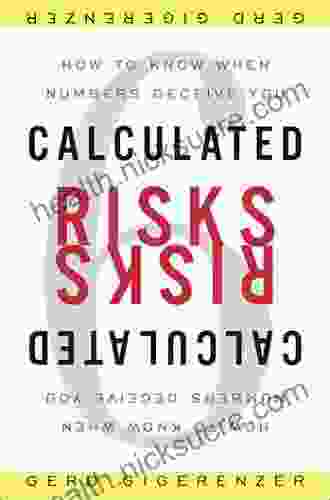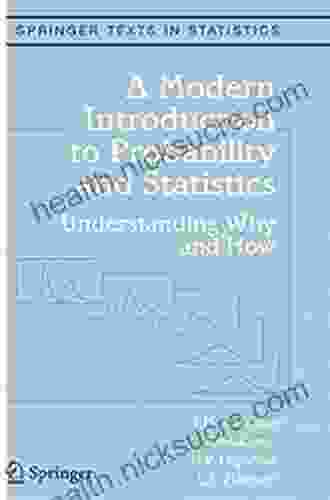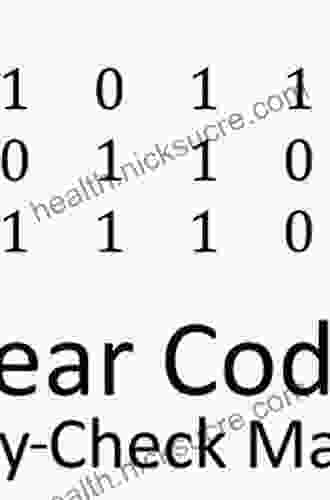How To Know When Numbers Deceive You

In an era of data explosion, we are constantly bombarded with numbers from various sources. While data can provide invaluable insights, it's crucial to be wary of potential deception. Numbers can be manipulated or misinterpreted, leading us to draw erroneous s.
4.4 out of 5
| Language | : | English |
| File size | : | 7485 KB |
| Text-to-Speech | : | Enabled |
| Screen Reader | : | Supported |
| Enhanced typesetting | : | Enabled |
| Word Wise | : | Enabled |
| Print length | : | 357 pages |
Tactics of Deception
Understanding the different tactics used to deceive with numbers is essential to identifying misleading statistics. Here are some common methods:
- Cherry-picking: Selecting only the data that supports a desired while ignoring contrary evidence.
- Sampling bias: Using a non-representative sample that leads to biased results.
- Correlation vs. causation: Mistaking correlation for causation, where two related events are assumed to have a cause-and-effect relationship when they don't.
- Hiding the denominator: Presenting data as percentages or ratios without providing the total number of cases, which can distort the true meaning.
- Truncated graphs: Cutting off a portion of a graph's vertical axis to exaggerate the magnitude of data changes.
Unmasking Deception
Identifying deception in numbers requires a combination of critical thinking and understanding of statistical principles. Here are some steps you can take:
1. Examine the Source:
Evaluate the credibility of the data source. Consider whether the organization has a vested interest in the outcome or if it has a reputation for accurate and impartial information.
2. Look for Context:
Understand the purpose and context of the data. Why is it being presented? What story is it trying to tell? Having a clear understanding of the context helps you assess the relevance and credibility of the data.
3. Examine the Data Presentation:
Scrutinize the way the data is presented. Are there any suspicious graphs or tables? Are key details missing or hidden? Pay attention to the scale, labeling, and units of measurement used.
4. Test for Skewness:
Identify any obvious outliers or extreme values that could skew the overall data. Calculate measures like mean, median, and standard deviation to understand the distribution of the data.
5. Beware of Assumptions:
Be wary of implicit or explicit assumptions made in the data analysis. Assumptions can lead to biased interpretations and incorrect s.
Preventing Manipulation
To prevent being manipulated by deceptive data, it's essential to develop data literacy. Here are some tips:
- Seek multiple sources: Don't rely on a single source of data. Gather information from diverse perspectives and compare them to form a more well-rounded understanding.
- Understand statistical concepts: Familiarize yourself with basic statistical principles and terminology to better evaluate the validity of data.
- Be skeptical: Approach data with a critical mindset. Question the assumptions and methods used in the analysis.
- Consult experts: If necessary, seek advice from statisticians or data analysts to help interpret complex data.
Understanding how numbers can deceive is essential for making informed decisions based on data. By being aware of the tactics of deception and developing data literacy, you can identify misleading statistics, uncover the truth behind the numbers, and avoid being manipulated by untrustworthy data.
In the age of information overload, data skepticism and critical thinking are more important than ever. By questioning the data you encounter, understanding its context, and examining its presentation, you can empower yourself to make more informed decisions and avoid falling victim to deception.
4.4 out of 5
| Language | : | English |
| File size | : | 7485 KB |
| Text-to-Speech | : | Enabled |
| Screen Reader | : | Supported |
| Enhanced typesetting | : | Enabled |
| Word Wise | : | Enabled |
| Print length | : | 357 pages |
Do you want to contribute by writing guest posts on this blog?
Please contact us and send us a resume of previous articles that you have written.
 Fiction
Fiction Non Fiction
Non Fiction Romance
Romance Mystery
Mystery Thriller
Thriller SciFi
SciFi Fantasy
Fantasy Horror
Horror Biography
Biography Selfhelp
Selfhelp Business
Business History
History Classics
Classics Poetry
Poetry Childrens
Childrens Young Adult
Young Adult Educational
Educational Cooking
Cooking Travel
Travel Lifestyle
Lifestyle Spirituality
Spirituality Health
Health Fitness
Fitness Technology
Technology Science
Science Arts
Arts Crafts
Crafts DIY
DIY Gardening
Gardening Petcare
Petcare Steve J Martin
Steve J Martin Bill Varney Jr
Bill Varney Jr Marie Osmond
Marie Osmond D C Fergerson
D C Fergerson Scott Smith
Scott Smith Jason Durham
Jason Durham Franz Kellermann
Franz Kellermann Jim Cobb
Jim Cobb Robert Taylor
Robert Taylor Joseph Harkreader
Joseph Harkreader Jim Cheney
Jim Cheney Michelle Nijhuis
Michelle Nijhuis Daniel J Levitin
Daniel J Levitin Mary Bergin
Mary Bergin Elce Junior Lauriston
Elce Junior Lauriston Allan Hall
Allan Hall Maria Thompson Daviess
Maria Thompson Daviess Alison Aulakh
Alison Aulakh Gail Steketee
Gail Steketee Tami Overhauser
Tami Overhauser Marc Bubbs
Marc Bubbs Arianna Brooks
Arianna Brooks Ashley D Kendall
Ashley D Kendall Allistair Mccaw
Allistair Mccaw Rex L Forehand
Rex L Forehand Richard M Van Gaasbeek
Richard M Van Gaasbeek Robert M Sapolsky
Robert M Sapolsky Robert Penn Warren
Robert Penn Warren Wendelin Van Draanen
Wendelin Van Draanen James Ferguson
James Ferguson Cy Tymony
Cy Tymony Susan Neiman
Susan Neiman Teri Moser Woo
Teri Moser Woo Beth Cavenaugh
Beth Cavenaugh Jen Torborg
Jen Torborg Bill Horn
Bill Horn Linda Barrett Osborne
Linda Barrett Osborne David Hurst Thomas
David Hurst Thomas Pass Your Class
Pass Your Class Catherine Gildiner
Catherine Gildiner Helen Macdonald
Helen Macdonald Nick Karas
Nick Karas Ed Robinson
Ed Robinson Jim Downs
Jim Downs Greg Moran
Greg Moran Raychelle Cassada Lohmann
Raychelle Cassada Lohmann Frank Christianson
Frank Christianson Mike Wallace
Mike Wallace Annabeth Headrick
Annabeth Headrick Don Harris
Don Harris Lynn Stafford Yilmaz
Lynn Stafford Yilmaz Rachel Caine
Rachel Caine Victor Canning
Victor Canning Mara Krechevsky
Mara Krechevsky John Lloyd
John Lloyd Sabatino Moscati
Sabatino Moscati Bret Hart
Bret Hart S Allen Counter
S Allen Counter C S Wilde
C S Wilde Ronald Hutton
Ronald Hutton Liz Clark
Liz Clark David F Anderson
David F Anderson Laerke Recht
Laerke Recht Randy Olson
Randy Olson Christopher Bruhn
Christopher Bruhn Chris Chambers
Chris Chambers Jim C Hines
Jim C Hines Laura Randall
Laura Randall Y R Davis
Y R Davis Rodney Ford
Rodney Ford Tami Asars
Tami Asars Signe Pike
Signe Pike Alisha J Brown
Alisha J Brown Allan Kardec
Allan Kardec Lydia Sherrer
Lydia Sherrer Walter Isaacson
Walter Isaacson Winston Churchill
Winston Churchill Brett Lee Scott
Brett Lee Scott Grant Petersen
Grant Petersen Eric Newby
Eric Newby Kimberly Brown
Kimberly Brown Christian Asonye
Christian Asonye Michael Fullan
Michael Fullan N B Hankes
N B Hankes Paul J Kosmin
Paul J Kosmin Norrinda Brown Hayat
Norrinda Brown Hayat Allan Phillips
Allan Phillips Allen Everett
Allen Everett Olajumoke Adenowo
Olajumoke Adenowo Steven J Burton
Steven J Burton Chris Cannon
Chris Cannon Henry Cloud
Henry Cloud Judy Converse
Judy Converse Konnie Wong
Konnie Wong Allen J Christenson
Allen J Christenson Sam Jefferson
Sam Jefferson Todd Wilbur
Todd Wilbur Perry Lefko
Perry Lefko Jim Rahtz
Jim Rahtz 10th Edition Kindle Edition
10th Edition Kindle Edition Maria Hannay
Maria Hannay Holly Homer
Holly Homer Bruce Tremper
Bruce Tremper Joanna Foley Rd
Joanna Foley Rd L H Nicole
L H Nicole Saint Teresa Of Avila
Saint Teresa Of Avila Diana Korte
Diana Korte Frederick Courteney Selous
Frederick Courteney Selous Sharon Weinberger
Sharon Weinberger Alicia Thomas Woolf
Alicia Thomas Woolf Allen R Angel
Allen R Angel Brian Lopes
Brian Lopes Edwin Amenta
Edwin Amenta Muthukumaran Mani
Muthukumaran Mani Gavin Fairbairn
Gavin Fairbairn W Edwards Deming
W Edwards Deming Carlos Castaneda
Carlos Castaneda John Shewey
John Shewey Gary Leland
Gary Leland Peggy L Chinn
Peggy L Chinn Harald B Teicher
Harald B Teicher Ian Westermann
Ian Westermann Pamela Douglas
Pamela Douglas Bryan Goodwin
Bryan Goodwin Jason Padgett
Jason Padgett Sportsman S Connection
Sportsman S Connection Jenara Nerenberg
Jenara Nerenberg Linda Martella Whitsett
Linda Martella Whitsett J R R Tolkien
J R R Tolkien Trae Dorn
Trae Dorn Andrew Kastor
Andrew Kastor Elliot Aronson
Elliot Aronson Natasha Devon
Natasha Devon Lionel Cruzille
Lionel Cruzille Katy Milkman
Katy Milkman Jeff Brent
Jeff Brent Tim Hodkinson
Tim Hodkinson Tom Watson
Tom Watson Eddie Guerrero
Eddie Guerrero Ryan Hall
Ryan Hall Aly Raisman
Aly Raisman Cate Stillman
Cate Stillman Joe Vasicek
Joe Vasicek Joe Kenn
Joe Kenn Monique Joiner Siedlak
Monique Joiner Siedlak Jonathan St B T Evans
Jonathan St B T Evans Alexandra Amor
Alexandra Amor Vivian Gornick
Vivian Gornick Mian Majid Ali Afzal
Mian Majid Ali Afzal Selene Yeager
Selene Yeager Iain Gately
Iain Gately Karen Blumenthal
Karen Blumenthal Allison Norfolk
Allison Norfolk Ken Cohen
Ken Cohen Jeff Hawkins
Jeff Hawkins Chris Fox
Chris Fox Michele Stanten
Michele Stanten John Bul Dau
John Bul Dau Matt Hart
Matt Hart Alicia Jasinska
Alicia Jasinska Shawn D Madden
Shawn D Madden Jon S Bailey
Jon S Bailey Vitalis I Valentine
Vitalis I Valentine Brian Treanor
Brian Treanor Kate Clifford Larson
Kate Clifford Larson Michaelbrent Collings
Michaelbrent Collings Rex Allen Jones Ii
Rex Allen Jones Ii David Hancock
David Hancock Allen G Taylor
Allen G Taylor Edmund G R Kraal
Edmund G R Kraal Deborah Macnamara Phd
Deborah Macnamara Phd Lewis Carroll
Lewis Carroll Tom Babin
Tom Babin The School Of Life
The School Of Life Charlotte Runcie
Charlotte Runcie Joe Kelly
Joe Kelly Leah Vanderveldt
Leah Vanderveldt Matthew Syed
Matthew Syed Felix Marks
Felix Marks Kevin Leman
Kevin Leman Kate Mcmahon
Kate Mcmahon Casi Mclean
Casi Mclean The Editors Of Outside Magazine
The Editors Of Outside Magazine Nick Riley
Nick Riley Roy Clark
Roy Clark David Eagleman
David Eagleman Tom Kelly
Tom Kelly Apryl Baker
Apryl Baker Roy Macskimming
Roy Macskimming Noor Ain
Noor Ain Bobby Clampett
Bobby Clampett Meritxell Castells
Meritxell Castells Paul Green
Paul Green Geoff Salmon
Geoff Salmon Dr Danielle Ward
Dr Danielle Ward P Schreiber
P Schreiber Etienne Noumen
Etienne Noumen Clive Cussler
Clive Cussler Jack Smith
Jack Smith Meredith Russo
Meredith Russo Karen Murphy
Karen Murphy Raymond Turner
Raymond Turner Allison Mcdonald Ace
Allison Mcdonald Ace Joshua Elliot James
Joshua Elliot James Joel Thomas Chopp
Joel Thomas Chopp Douglas Whynott
Douglas Whynott Emily Thiede
Emily Thiede Novak Djokovic
Novak Djokovic Karen Bonnell
Karen Bonnell Glenn Tinnin
Glenn Tinnin Chris Mulder
Chris Mulder Mark Beauregard
Mark Beauregard Alison Scott Wright
Alison Scott Wright Cinda Williams Chima
Cinda Williams Chima John Macinnes
John Macinnes Allen Morris Jones
Allen Morris Jones Julie Currin
Julie Currin Giancarlo Lemmi
Giancarlo Lemmi William W Dressler
William W Dressler Stephen R Covey
Stephen R Covey Bill Hendricks
Bill Hendricks Robert S Witte
Robert S Witte Ben Greenfield
Ben Greenfield Rick Johnson
Rick Johnson Jennifer E Smith
Jennifer E Smith Mark Kistler
Mark Kistler Carrot Quinn
Carrot Quinn Michael Reist
Michael Reist Douglas Nicholas
Douglas Nicholas Segun Adebajo
Segun Adebajo James Patterson
James Patterson Vincent Schilling
Vincent Schilling Hilda Jarman Muir
Hilda Jarman Muir Brenda Boyd
Brenda Boyd Anna Leinberger
Anna Leinberger Alistair Brownlee
Alistair Brownlee Lisa Marshall
Lisa Marshall Eugen Herrigel
Eugen Herrigel Allen Carr
Allen Carr Robbin Gregory
Robbin Gregory Kathleen Bachynski
Kathleen Bachynski Jean Jacques Chevron
Jean Jacques Chevron Michael Shermer
Michael Shermer Bogdan Ivanov
Bogdan Ivanov David M Killoran
David M Killoran Mandi Hickman
Mandi Hickman Anna Costaras
Anna Costaras Allison Arevalo
Allison Arevalo Rhonda Huettenmueller
Rhonda Huettenmueller Matthew Mccoy
Matthew Mccoy Nikki Solano
Nikki Solano Milton Gussow
Milton Gussow Sean Patrick
Sean Patrick John Bargh Ph D
John Bargh Ph D Kaitlyn Hill
Kaitlyn Hill Lsatmax Lsat Prep
Lsatmax Lsat Prep John Novosel Jr
John Novosel Jr Paul S Auerbach
Paul S Auerbach Peter Van Der Linden
Peter Van Der Linden Kevin West
Kevin West Joel S Owen
Joel S Owen Alistair Cooke
Alistair Cooke Barbara De Angelis
Barbara De Angelis Dennis Georgatos
Dennis Georgatos Shobi Nolan
Shobi Nolan Meredith L Jacobs
Meredith L Jacobs James Kipling
James Kipling Judith Rich Harris
Judith Rich Harris Matthieu Auzanneau
Matthieu Auzanneau Allen M Hornblum
Allen M Hornblum Dan Millman
Dan Millman Brenda Gable
Brenda Gable Peter Hollins
Peter Hollins Danica G Hays
Danica G Hays Maria Rickert Hong
Maria Rickert Hong Dennis Jarecke
Dennis Jarecke Lynn Acton
Lynn Acton Marianne Williamson
Marianne Williamson Stephen Haddelsey
Stephen Haddelsey Allen O Bannon
Allen O Bannon Allan Trevor
Allan Trevor Jonathan Moeller
Jonathan Moeller Linda Greenlaw
Linda Greenlaw Phil Hornshaw
Phil Hornshaw Allison Alexy
Allison Alexy Pure Calisthenics
Pure Calisthenics Tim Rappleye
Tim Rappleye Leonard Shlain
Leonard Shlain Arthur Aughey
Arthur Aughey Sheena Byrom
Sheena Byrom Carlo Ancelotti
Carlo Ancelotti Alistair Higham
Alistair Higham Carla Simpson
Carla Simpson Paul Schullery
Paul Schullery William Stott
William Stott Marti Olsen Laney
Marti Olsen Laney Gary Sizer
Gary Sizer Allen Dulles
Allen Dulles Alina A Von Davier
Alina A Von Davier Alison Palmer
Alison Palmer Kenneth Igiri
Kenneth Igiri Julie Schwietert
Julie Schwietert Alison Gervais
Alison Gervais Mary Quinlan Mcgrath
Mary Quinlan Mcgrath Travis Jeffery
Travis Jeffery Roger Bannister
Roger Bannister Priya Ardis
Priya Ardis Maurice Isserman
Maurice Isserman Tom Daley
Tom Daley Alison Pearlman
Alison Pearlman Frank Delaney
Frank Delaney Joe Sparrow
Joe Sparrow P J Richards
P J Richards Despina Meris
Despina Meris Jim Mancuso
Jim Mancuso Allison Schrager
Allison Schrager Joseph Fort Newton
Joseph Fort Newton Robin Riley
Robin Riley Giuseppe Mascoli
Giuseppe Mascoli Charles Conn
Charles Conn Gerd Gigerenzer
Gerd Gigerenzer Judith Mckay
Judith Mckay Stuart A Kauffman
Stuart A Kauffman Neil Hayes
Neil Hayes Philip Gosse
Philip Gosse Chip Coffey
Chip Coffey Mourad Boufadene
Mourad Boufadene Tim Roughgarden
Tim Roughgarden Allen Stroud
Allen Stroud Josephine Perry
Josephine Perry Richard H Thaler
Richard H Thaler Ethem Mining
Ethem Mining Allan G Bluman
Allan G Bluman Jeffrey E Young
Jeffrey E Young Jennifer Waldburger
Jennifer Waldburger Chris Lear
Chris Lear Jacqueline H Wolf
Jacqueline H Wolf Jeff Burlingame
Jeff Burlingame Ann C Logue
Ann C Logue Nevin Martell
Nevin Martell Emma Shelford
Emma Shelford Itzik Ben Gan
Itzik Ben Gan Greg Henry
Greg Henry Rene Almeling
Rene Almeling Susan Ware
Susan Ware Eric Naguski
Eric Naguski Richard Kaczynski
Richard Kaczynski John Hughes
John Hughes Allison Dolan
Allison Dolan Roy Shepard
Roy Shepard Daniel Stewart
Daniel Stewart Molly Forbes
Molly Forbes Carla Mooney
Carla Mooney Rob Shelsky
Rob Shelsky Paul D Brinkman
Paul D Brinkman Somaiya Daud
Somaiya Daud Daniel J Siegel
Daniel J Siegel Julie Morgenstern
Julie Morgenstern Robert Kiltz
Robert Kiltz Erica Abbett
Erica Abbett Jorge Muniz
Jorge Muniz Alexander Clarke
Alexander Clarke Alister E Mcgrath
Alister E Mcgrath Gregory Cochran
Gregory Cochran Andrew Benfield
Andrew Benfield Stuart Holmes Coleman
Stuart Holmes Coleman John Kavanagh
John Kavanagh Alivia Stephens
Alivia Stephens C Calvin Jones
C Calvin Jones Jeremy Evans
Jeremy Evans Kwame Onwuachi
Kwame Onwuachi Sarah P Morris
Sarah P Morris Courtney Summers
Courtney Summers James Fallows
James Fallows George Buehler
George Buehler Kenji Tokitsu
Kenji Tokitsu Claude Levi Strauss
Claude Levi Strauss Naomi Kokoricha
Naomi Kokoricha Jonathan E Steinhart
Jonathan E Steinhart Kota Nozomi
Kota Nozomi The Dark Lords
The Dark Lords Milt Rosko
Milt Rosko Lynn Rush
Lynn Rush Mark Dice
Mark Dice Godfrey Higgins
Godfrey Higgins Jay Blahnik
Jay Blahnik Kim Heacox
Kim Heacox Amy Wenzel
Amy Wenzel Alison Lighthall Miller
Alison Lighthall Miller Marc Vachon
Marc Vachon Jim Bell
Jim Bell Daniel Mendelsohn
Daniel Mendelsohn Eli Saslow
Eli Saslow Linda S Jones
Linda S Jones Aubrey Gordon
Aubrey Gordon Aliza Kelly
Aliza Kelly Debra L Martin
Debra L Martin Toru Toba
Toru Toba Petr Zima
Petr Zima Lisa M Rose
Lisa M Rose Grant S Lipman
Grant S Lipman Myrna Blyth
Myrna Blyth Emily Parke Chase
Emily Parke Chase Linda A Curtis
Linda A Curtis Justin J Exner
Justin J Exner Frederick Mosteller
Frederick Mosteller Jennifer Louden
Jennifer Louden Allen N Mendler
Allen N Mendler Kate Wood
Kate Wood Anil Seth
Anil Seth Neely Spence Gracey
Neely Spence Gracey Deborah Ann Davis
Deborah Ann Davis Scott Graham
Scott Graham Peter Mark Adams
Peter Mark Adams Karen Wambach
Karen Wambach Brian Boone
Brian Boone Lennard Bickel
Lennard Bickel Sid Roth
Sid Roth Eickhel Mendoza
Eickhel Mendoza Liz Evers
Liz Evers Dr Ron M Horner
Dr Ron M Horner Carl Paoli
Carl Paoli Tim Baker
Tim Baker Edmund Richardson
Edmund Richardson John Michael Kelly
John Michael Kelly Alan Watts
Alan Watts Carolyn Shearlock
Carolyn Shearlock William B Helmreich
William B Helmreich Charles J Robinson
Charles J Robinson Dan Miller
Dan Miller Sarah Grison
Sarah Grison Randy Russell
Randy Russell Debi Pearl
Debi Pearl J Richard Gott
J Richard Gott Theodore B Sauselein
Theodore B Sauselein Mike Zimmerman
Mike Zimmerman Pasco Valana
Pasco Valana Allan House
Allan House Don Miguel Ruiz
Don Miguel Ruiz Jared Cohen
Jared Cohen Kelsey Banfield
Kelsey Banfield Grace Lindsay
Grace Lindsay Mark F Sohn
Mark F Sohn William A Haviland
William A Haviland Rowena Murray
Rowena Murray Ron Merly
Ron Merly Mary Elizabeth O Brien
Mary Elizabeth O Brien Marlin M Mackenzie
Marlin M Mackenzie Allison Williams
Allison Williams Jimena Canales
Jimena Canales Rebecca St James
Rebecca St James Kim Liggett
Kim Liggett John C Lennox
John C Lennox Jeff Gordon
Jeff Gordon Lexie Scott
Lexie Scott Andrie De Vries
Andrie De Vries Allison Tyson
Allison Tyson Chris Lundgren
Chris Lundgren Tiger Woods
Tiger Woods Patrick Stewart
Patrick Stewart Eric Lemarque
Eric Lemarque W E Fairbairn
W E Fairbairn James F Mckenzie
James F Mckenzie Stephen E Flowers
Stephen E Flowers Alicia F Lieberman
Alicia F Lieberman Simone Milasas
Simone Milasas Sylvia Larsen
Sylvia Larsen George M Johnson
George M Johnson Dennis Overbye
Dennis Overbye Amby Burfoot
Amby Burfoot Valerie Gilpeer
Valerie Gilpeer Ryan Spaeder
Ryan Spaeder Annie F Downs
Annie F Downs Robert Green
Robert Green Dr Nadine Sinclair
Dr Nadine Sinclair Tress Bowen
Tress Bowen Amy Saltzman
Amy Saltzman Thomas R Verny
Thomas R Verny Kaylee Cole
Kaylee Cole Greg Strandberg
Greg Strandberg Grace E Stewart
Grace E Stewart Joosr
Joosr Dr Fiona Mcpherson
Dr Fiona Mcpherson Ronald E Mickens
Ronald E Mickens Kristine Hudson
Kristine Hudson Dan Abrahams
Dan Abrahams Suzanne O Sullivan
Suzanne O Sullivan Bright Summaries
Bright Summaries James Sieckmann
James Sieckmann Susan Kuklin
Susan Kuklin Janet E Wall
Janet E Wall Kara Lawrence
Kara Lawrence Robin Stevenson
Robin Stevenson Jdmission Senior Consultants
Jdmission Senior Consultants Dave Pelz
Dave Pelz Fluent In Korean
Fluent In Korean Suzanne Alderson
Suzanne Alderson Pottermore Publishing
Pottermore Publishing Suzanne Nottingham
Suzanne Nottingham Christina Hoff Sommers
Christina Hoff Sommers
Light bulbAdvertise smarter! Our strategic ad space ensures maximum exposure. Reserve your spot today!
 Percy Bysshe ShelleyFollow ·19k
Percy Bysshe ShelleyFollow ·19k Maurice ParkerFollow ·4.8k
Maurice ParkerFollow ·4.8k Leo TolstoyFollow ·4.7k
Leo TolstoyFollow ·4.7k Martin CoxFollow ·14.9k
Martin CoxFollow ·14.9k Osamu DazaiFollow ·2.7k
Osamu DazaiFollow ·2.7k Edward BellFollow ·11.9k
Edward BellFollow ·11.9k Julio Ramón RibeyroFollow ·15.2k
Julio Ramón RibeyroFollow ·15.2k Bill GrantFollow ·18.4k
Bill GrantFollow ·18.4k

 Dominic Simmons
Dominic SimmonsFierce Attachments: A Memoir by Vivian Gornick - A...
Vivian Gornick's Fierce Attachments is a...

 Edison Mitchell
Edison MitchellPrimer for America's Favorite Wilderness: A Comprehensive...
In the vast...

 Jan Mitchell
Jan MitchellIntroduction to Probability: A Comprehensive Guide for...
Probability is a crucial branch of...

 Chuck Mitchell
Chuck Mitchell100,000 Mile Journey Into the Heart of America
In 2016, I embarked on a...

 Eddie Bell
Eddie BellHow Schools Around the World Are Inspiring Greatness One...
Education is the key...

 Quentin Powell
Quentin PowellJourney into the Heart of Alaska: Exploring the Majestic...
Alaska, the largest...
4.4 out of 5
| Language | : | English |
| File size | : | 7485 KB |
| Text-to-Speech | : | Enabled |
| Screen Reader | : | Supported |
| Enhanced typesetting | : | Enabled |
| Word Wise | : | Enabled |
| Print length | : | 357 pages |












